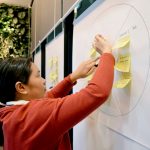I am seeing a lot nowadays when I get a new UX designer
Everyone Looks the Same
Open LinkedIn, Behance, or Dribbble and scroll through UI/UX portfolios—what do you see? An endless array of case studies featuring Spotify redesigns, Airbnb clones, and imaginary fintech apps. While they may look polished, they often lack originality.
In 2025, the design world is oversaturated with portfolios that play it safe. The issue? Many designers rely on the same templates from online courses, failing to apply unique problem-solving and real-world thinking.
Why This is a Problem:
Hiring managers are desperate to see how you think, not just what you can create. They need designers who grasp user psychology, business goals, and product-market fit—not just someone who can produce another clean UI featuring neumorphism or glassmorphism trends.
Surface-Level Understanding of UX
Many designers can discuss wireframes, user flows, or personas, but often only at a superficial level. In interviews, when pressed about their UX decisions, 90% of candidates struggle to connect their designs to measurable results or human-centered insights.
Why This is a Problem:
UX is more than just appealing flows; it’s about creating products that address real pain points and generate value for users and businesses alike. By 2025, companies are seeking designers who deeply understand user behavior, product strategy, and data-driven design.
No Real-World Collaboration Experience
The reality is that in professional environments, you seldom work in isolation. Yet, many designers have never collaborated within cross-functional teams. They haven’t navigated conflicting stakeholder demands, engineering limitations, or business constraints.
Why This is a Problem:
In 2025, companies want designers who can navigate team dynamics, negotiate trade-offs, and defend their decisions when challenged by product leads or CTOs. Hiring someone who only knows how to work independently on fictional projects is a gamble.
Over-Reliance on AI Tools
AI is revolutionizing design. Tools like Figma AI, Uizard, and other no-code platforms have made wireframing and prototyping faster and easier. However, many designers are over-relying on AI to do the heavy lifting, resulting in cookie-cutter layouts that lack critical thinking.
Why This is a Problem:
Hiring managers can easily spot AI-generated work. While tools can produce layouts, they cannot replicate empathy, business intuition, or creative problem-solving. In 2025, human-centered thinking will be your greatest asset, not just proficiency with the latest AI tool.
Poor Storytelling in Case Studies
A common mistake is treating your portfolio as an art gallery instead of a narrative. Hiring teams want to see not just your final UI screens but also hear the story behind each project—the challenges, insights, trade-offs, and outcomes.
Why This is a Problem:
A case study devoid of storytelling feels shallow and forgettable. In 2025, storytelling will be critical for standing out. Without it, even your best work will blend into a sea of sameness.
Remember: hiring managers want to hire problem solvers, not just screen designers.



